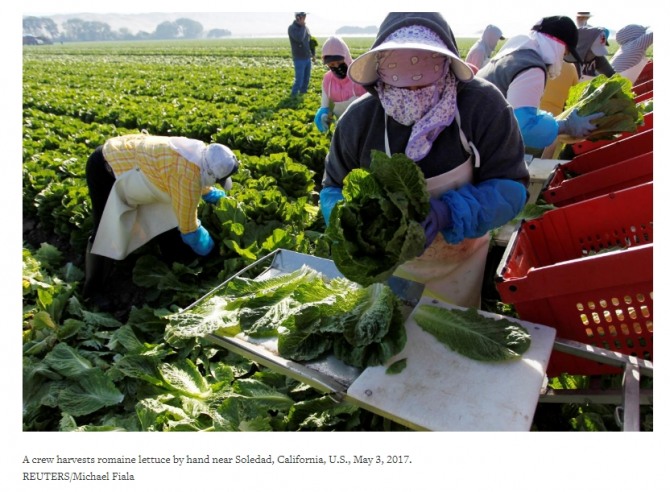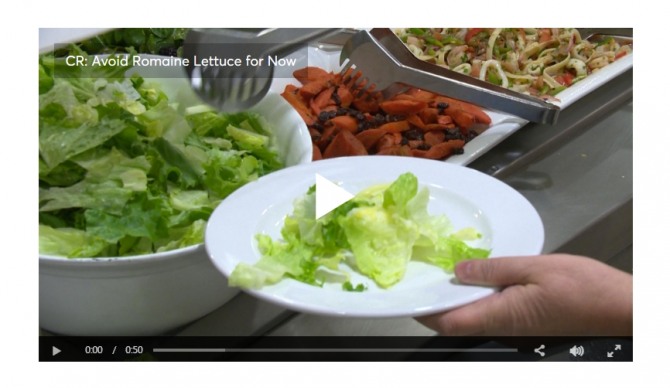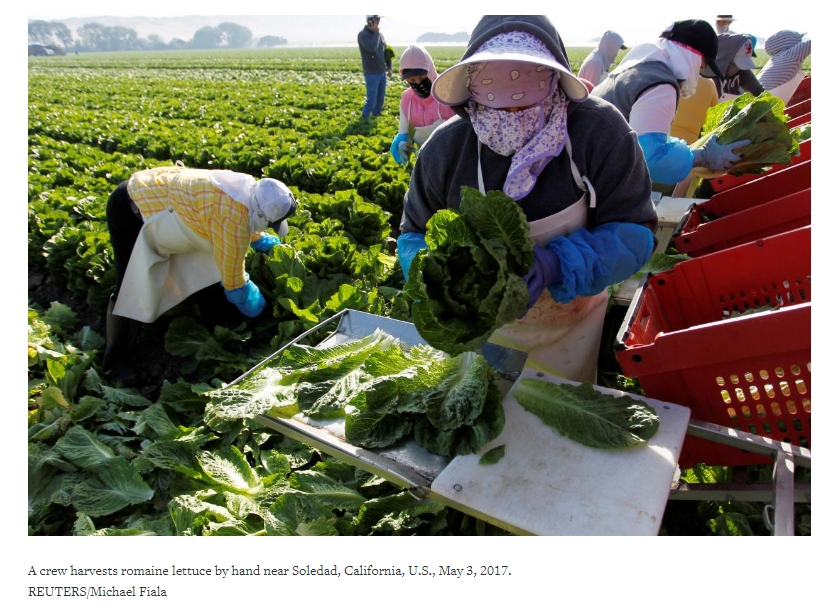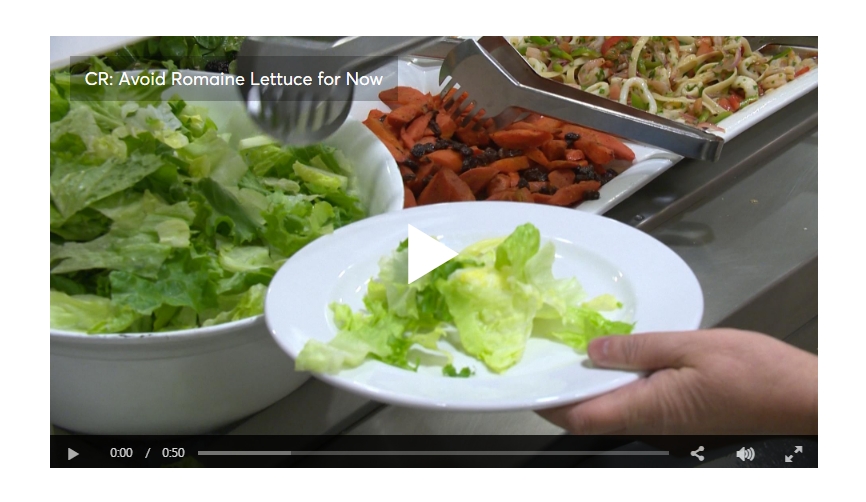미국 캐나다에서 식중독· 대장염 감염 58명 사상
[글로벌이코노믹 김대호 기자] 상추를 먹으면 식중독 등으로 사망할 수도 있다는 경고가 나왔다.  이미지 확대보기
이미지 확대보기미국 최대의 소비자단체인 소비자연맹은 5일 발행한 기관지 컨슈머리포트에서 “로메인 상추에서 급성 장염을 일으키는 병원성 대장균이 검출되는 것으로 보인다”면서 “로메인 상추를 피하라”고 경고했다.
컨슈머리포트의 이 보고서 원문은 “Avoid Romaine Lettuce for Now”로 되어 있다. 지금 바로 로메인 상추를 피하라는 뜻이다. 컨슈머리포트는 이어 “This salad green is likely the cause of recent cases of E. coli food poisoning”라고 지적하고 있다. 이 푸른 채소 즉 로메인 상추가 최근 잇달아 터지고 있는 음식을 통한 병원성 대장균 감염의 원인으로 보인다는 내용이다.
‘E. coli’는 대장균을 의미한다. 독일의 소아과의사이면서 박테리아연구학자인 테오도르 에쉐리히가 1885년에 발견한 것이다. 그의 이름을 기려 이 균의 이름을 Escherichia 대장균 즉 Escherichia coli로 부르고 있다. 그중 에쉐리히(Escherichia)의 앞 알파벳 첫 글자 E를 따와 ‘E. coli’ 라고 부른다. 박테리아의 일종이다. 이 박테리아는 온혈동물의 창자 그중에서도 대장과 소장에서 주로 기생하고 있다.
대부분의 대장균과 그 변종은 인체에 해롭지 않다. 오히려 비타민 K2등을 생산하여 이로움을 준다. 병의 원인이 되는 박테리아의 번식을 막기도 한다. 문제는 항원형 O157 대 H7이다. 이 대장균은 사람에게 식중독을 일으킨다.
컨슈머 리포트지는 이러한 인체에 유해한 대장균이 최근 로메인 상추에서 검출되고 있는 것 같다고 보고 있다. 이를 병원성 대장균으로 통칭한다.
이 병원성 대장균에 의한 장염 또는 식중독 감염 사례가 최근 미국과 캐나다에서 이어지고 있다. 최근 한 달반 동안 미국의 13개 주와 캐나다 5개 주에서 로메인 상추가 원인으로 추정되는 병원성 대장균 감염 사태가 발생해 2명이 숨지고 58명이 병원 치료를 받은 것이다.
미국과 캐나다의 보건 당국은 그 감염 환자들에게서 공통적으로 장출혈성 대장균(O157 대 H7)이 검출됐다고 밝혔다. 캐나다 보건당국은 이번 식중독 사태의 원인을 대장균에 오염된 로메인 상추로 발표했다. 캐나다 보건 당국 특히 온타리오와 퀘벡 뉴브런스윅, 노바스코샤, 뉴펀들랜드, 래브라도 주 주민들에게 "정확한 원인과 경로가 규명될 때까지 로메인 상추를 피하라"고 당부했다.
미국 질병통제예방센터(CDC)는 아직 결론을 내리지는 않고 있다. CDC 는 최근 언론 인터뷰에서 “아직 조사가 진행 중"이라며 “매개체를 최종 확인하지는 않았다"고 밝혔다.
컨슈머리포트지는 이에 대해 “CDC 최종 발표는 아직 나오지 않았으나 자체 조사를 통해 로메인 상추가 식중독의 원인으로 밝혀졌다”고 밝혔다. 그러면서 "당분간 로메인 상추 섭취를 자제하라"고 권고했다.
 이미지 확대보기
이미지 확대보기다음은 관련기사 발췌
Avoid Romaine Lettuce for Now, Consumer Reports Says
This salad green is likely the cause of recent cases of E. coli food poisoning
Over the past seven weeks, 58 people in the U.S. and Canada have become ill from a dangerous strain of E. coli bacteria, likely from eating romaine lettuce. In the U.S., the infections have occurred in 13 states (California, Connecticut, Illinois, Indiana, Michigan, Nebraska, New Hampshire, New York, Ohio, Pennsylvania, Virginia, Vermont, and Washington state). Five people in the U.S. have been hospitalized and one has died, according to the Centers for Disease Control and Prevention (CDC). There has also been one death in Canada.
Canadian health authorities identified romaine lettuce as the source of the outbreak in Canada, and are advising people in the country’s eastern provinces to consider eating other types of salad greens until further notice. In the U.S., government health officials are investigating the outbreaks, but have stopped short of recommending people avoid romaine lettuce or any other food.
This strain of E. coli (0157:H7) produces a toxin that in some cases can lead to serious illness, kidney failure, and even death.
That’s why Consumer Reports' food safety experts are advising that consumers stop eating romaine lettuce until the cause of the outbreak is identified and the offending product is removed from store shelves.
“Even though we can’t say with 100 percent certainty that romaine lettuce is the cause of the E. coli outbreak in the U.S., a greater degree of caution is appropriate given that lettuce is almost always consumed raw,” says James Rogers, Ph.D., Director of Food Safety and Research at Consumer Reports.
While anyone can get sick if they are infected with E. coli 0157:H7, young children, the elderly, and anyone who has a condition (such as cancer or diabetes) that weakens the immune system are at greater risk. “People in these groups should be particularly vigilant about avoiding romaine lettuce,” says Rogers.
What U.S. Health Authorities Are Doing
The CDC announced last week in a press release that, along with the FDA, it is investigating the E. coli infections in the U.S. According to the agency, the type of E. coli making people sick is genetically similar to the bacteria involved in the Canadian outbreak. Still, the agency says it does not have enough information to recommend people in the U.S. avoid a particular food.
“There is not enough epidemiologic evidence at this time to indicate a specific source of the illnesses in the United States,” says Brittany Behm, MPH, a CDC spokesperson. “Although some sick people reported eating romaine lettuce, preliminary data available at this time shows they were not more likely than healthy people to have eaten romaine, based on a CDC food consumption survey.” Health officials, Behm says, take action when there is clear and convincing information linking illness to a contaminated food.
“The FDA should follow the lead of the Canadian government and immediately warn the public about this risk,“ says Jean Halloran, Director of Food Policy Initiatives at Consumers Union, the policy and mobilization division of Consumer Reports.
“The available data strongly suggest that romaine lettuce is the source of the U.S. outbreak," she says. "If so, and people aren’t warned, more may get sick.”
Under the Food Safety Modernization Act, the FDA has the authority to recall a hazardous food if a company fails to do so, but in this case health authorities have not yet identified the specific source of the outbreak. However, nothing prohibits health authorities from issuing a general warning in situations like this one with romaine lettuce.
And even if there was a product to recall, Halloran notes that it may take awhile before there is any company or FDA action. According to a report released in December by the Inspector General’s office at the U.S. Department of Health and Human Services, the FDA has at times been slow to secure recalls, which may be voluntary or mandatory. FDA Commissioner Scott Gottlieb said in a statement that the report raised some "signficant concerns" and that while the FDA has addressed many of the issues raised in the report, "we still have more work to do."
“FDA needs to act promptly to protect consumers' health. People could eat a lot of potentially contaminated romaine while waiting for a company recall or for the CDC and FDA to identify the specific source of the outbreak and order a mandatory recall of the affected products,” Halloran explains.
How Lettuce Becomes Tainted
Outbreaks of toxin-producing E. coli are more typically linked to beef (the bacteria can get into the meat during slaughter and processing), especially ground beef, but infections from produce are not unheard of. Leafy greens, including romaine lettuce, were the cause of outbreaks from E. coli 0157:H7 in 2006, 2011, 2012, and 2013.
“Vegetables can be contaminated if animal feces are in the field or in irrigation or washing water,” says Rogers, “The bacteria can also be transmitted if a person who is carrying the bacteria doesn’t wash his or her hands after using the bathroom and then processes or prepares food.”
Washing your greens is a good idea, but won’t necessarily get rid of dangerous E. coli, which can cling to nooks and crannies in the leaves, Rogers notes.
What You Should Do Now
Neither the CDC or Canadian health officials have provided any information on where the romaine lettuce potentially involved in the illnesses was grown or processed, so for now, assume that any romaine lettuce, even when sold in bags and packages, could possibly be contaminated, Rogers says. Don’t buy romaine lettuce and don’t use any that you may have in your refrigerator until there is more information on the source of contamination. In their warning, the Canadian health officials noted that romaine lettuce can have a shelf life of up to five weeks, so lettuce you purchased a few weeks ago could still be contaminated. Check salad blends and mixes, too, and avoid those that contain romaine.
Symptoms of infection with E. coli 0157:H7 are severe stomach cramps, diarrhea (often bloody), and vomiting. Some people may have a slight fever.
The symptoms typically start 1 to 3 days after eating a contaminated food, but may occur as late as 10 days afterwards. The CDC recommends seeing a doctor if you have a high fever, bloody diarrhea, or severe vomiting, or if diarrhea lasts longer than 3 days.
About 5 to 10 percent of people infected with E. coli 0157:H7 may develop hemolytic uremic syndrome, a serious condition which affects the blood vessels and can lead to kidney failure and death. This condition (which includes symptoms such as extreme fatigue, decreased urination and paleness in the cheeks and under the eyes) typically occurs about 7 days after E. coli symptoms first start.
CR: Avoid Romaine Lettuce for Now
 이미지 확대보기
이미지 확대보기로메인 상추는 사람들이 즐겨먹는 상추의 일종이다. 로마의 시저가 특히 좋아했다 하여 로메인 상추라고 부른다. 샐러드에 많이 들어가는 채소다. 원산지인 에게해의 코스섬 지명을 따서 코스 상추로 부르기도 한다.
로메인 상추는 배추처럼 포기로 수확한다. 피부가 건조해지는 것을 막아주는 것은 물론이고 잇몸을 튼튼하게 하여 잇몸 출혈을 예방해주는 건강식품으로 알려져 왔다. 출산한 여성에는 젖 분비량을 증가시켜주기 때문에 산모에게 특히 좋은 것으로 유명하다. 포기 채 그대로 샐러드로 이용하고 잎을 떼어낸 것은 쌈으로 이용한다. 아삭아삭한 맛이 일품이다. 일반 상추와 달리 쓴맛이 적고 감칠맛이 나서 아이들에게도 인기가 높은 편이다.
김대호 기자 yoonsk828@g-enews.com












































